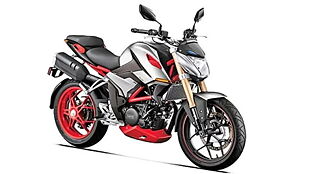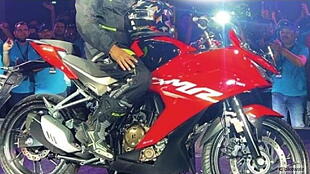Please Tell Us Your Location
This allows us to provide relevant content for you.
Popular Cities
Expected Price
Karizma 400 key highlights | |
|---|---|
| Transmission | Manual |

Bajaj Pulsar 220 F
220 cc, 38 kmpl, 20.11 bhp, 160 kg
Avg. Ex-showroom price
₹ 1,37,419
Zontes 350X
348 cc, 38.2 bhp, 6 Speed Manual
Avg. Ex-showroom price
₹ 3,45,000
Yamaha R15 V4
155 cc, 45 kmpl, 18.1 bhp, 141 kg
Avg. Ex-showroom price
₹ 1,81,704
Suzuki Gixxer SF 250
249 cc, 36 kmpl, 26.13 bhp, 161 kg
Avg. Ex-showroom price
₹ 1,88,799
QJ Motor SRC 250
249 cc, 17.16 bhp, 163 kg, 5 Speed Manual
Avg. Ex-showroom price
₹ 1,99,000
KTM 200 Duke
199.5 cc, 35 kmpl, 24.67 bhp, 159 kg
Avg. Ex-showroom price
₹ 1,92,936
Royal Enfield Classic 350
349 cc, 35 kmpl, 20.2 bhp, 195 kg
Avg. Ex-showroom price
₹ 1,93,080
Jawa Standard
294.72 cc, 30 kmpl, 26.95 bhp, 182 kg
Avg. Ex-showroom price
₹ 1,83,648
KTM RC 125
124.7 cc, 36.5 kmpl, 14.34 bhp, 160 kg
Avg. Ex-showroom price
₹ 1,89,628Couldn’t find what you were looking for?
View 200+ bikes from over 30 brands
Displacement --
Max Power --
Max Torque --
Stroke --
Valves Per Cylinder --
Compression Ratio --
Mileage - ARAI --
Mileage - Owner Reported --
Riding Range --
Top Speed --
Transmission Manual
Transmission Type --
Gear Shifting Pattern --
Cylinders --
Bore --
Ignition --
Spark Plugs --
Cooling System --
Clutch --
Fuel Delivery System --
Fuel Tank Capacity --
Reserve Fuel Capacity --
Emission Standard --
Fuel Type Petrol
Front Suspension --
Rear Suspension --
Braking System --
Rear Wheel Size --
Front Tyre Size --
Rear Tyre Size --
Front Brake Type --
Front Brake Size --
Rear Brake Type --
Rear Brake Size --
Calliper Type --
Wheel Type --
Front Wheel Size --
Tyre Type --
Radial Tyres --
Front Tyre Pressure (Rider) --
Rear Tyre Pressure (Rider) --
Front Tyre Pressure (Rider & Pillion) --
Rear Tyre Pressure (Rider & Pillion) --
Kerb Weight --
Seat Height --
Ground Clearance --
Overall Width --
Overall Height --
Wheelbase --
Overall Length --
Chassis Type --
Standard Warranty --
Standard Warranty --
Odometer --
Speedometer --
Fuel Guage --
AHO (Automatic Headlight On)--
Shift Light--
Headlight Type--
Digital Fuel Guage --
Tachometer --
Stand Alarm --
No. of Tripmeters --
Tripmeter Type --
Low Fuel Indicator --
Low Oil Indicator --
Low Battery Indicator --
Clock --
Battery --
Front storage box --
Under seat storage --
Mobile App Connectivity --
DRLs (Daytime running lights) --
Brake/Tail Light--
Turn Signal--
Pass Light--
GPS & Navigation--
USB charging port--
Start Type--
Killswitch--
Stepped Seat--
Pillion Backrest--
Pillion Grabrail--
Pillion Seat--
Pillion Footrest--
Additional features--
Never miss an update
Receive latest alerts from BikeWale
Please unblock notifications
Click on the of the address bar Site settings Notifications Turn on
Click on "Allow" to get latest updates
Hero showrooms in Hyderabad
38 showroomsHero showrooms in Chennai
37 showroomsHero showrooms in Delhi
36 showroomsHero showrooms in Bangalore
29 showroomsHero showrooms in Pune
21 showroomsHero showrooms in Kolkata
20 showroomsHero showrooms in Mumbai
14 showroomsHero showrooms in Lucknow
13 showroomsHero showrooms in India
1711 showrooms
Hero XF3R
Expected price
₹ 1,60,000 onwardsExpected launch
October 2023

Hero Xpulse 400
Expected price
₹ 1,70,000 onwardsExpected launch
October 2023

Hero Karizma XMR 210
Expected price
₹ 1,60,000 onwardsExpected launch
November 2023

Hero Xtreme 200S 4V
Expected price
₹ 1,40,000 onwardsExpected launch
December 2023

Hero Leap Hybrid SES
Expected price
₹ 74,000 onwardsExpected launch
December 2023
Q: What is the expected launch date of Hero Karizma 400?
Q: What will be the price of Hero Karizma 400 in India?
Here's a list of best Bikes

Royal Enfield Hunter 350
Avg. Ex-showroom price
₹ 1,49,900
Royal Enfield Classic 350
Avg. Ex-showroom price
₹ 1,93,080
Hero Splendor Plus
Avg. Ex-showroom price
₹ 72,465
Royal Enfield Bullet 350
Avg. Ex-showroom price
₹ 1,50,894
Honda Activa 6G
Avg. Ex-showroom price
₹ 76,826
TVS Raider 125
Avg. Ex-showroom price
₹ 91,356
Honda SP 125
Avg. Ex-showroom price
₹ 85,862
KTM 200 Duke
Avg. Ex-showroom price
₹ 1,92,936
Yamaha MT 15 V2
Avg. Ex-showroom price
₹ 1,65,903To get updates about
Please Tell Us Your Location
City
Area